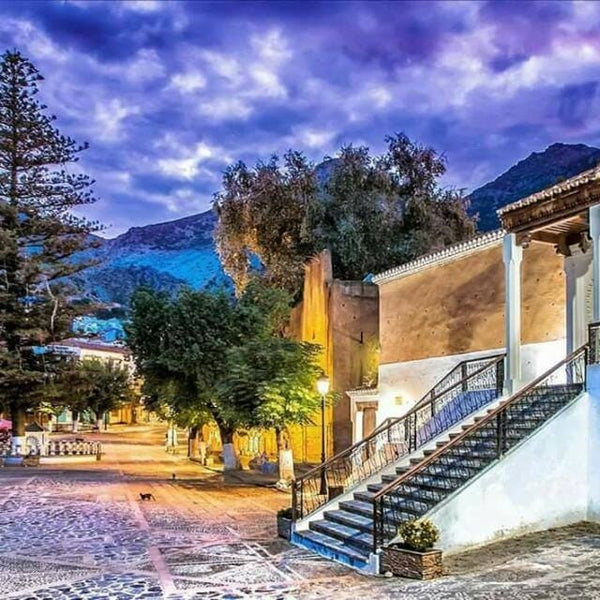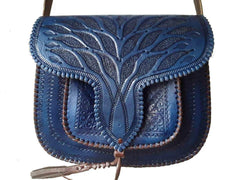Chefchaouen (or simply Chaouen) is a charming small town in the Rif mountain. Located at the foot of two mountains, Jebel Kela and Tissouka, it has also derived its name (meaning chefchaouen "the two horns"). Nicknamed "the holy city" for its many religious buildings, it also has probably the most beautiful Medina in the Rif area of Morocco.
In this beautiful scenery of mountains, it is an ideal location as "base camp" while on holiday, since it is both the starting point for hiking, it is particularly quiet and relaxing there while having beautiful beaches nearby (50km magnificent roads).
Chefchaouen: meaning
The name consists of two words: "Chouf" which means "look" and "echaouen" the plural of "ech" in Amazigh, which means "horn" pointing and often the top of the mountain. Therefore, the meaning of "Chefchaouen" would then be "watch the horns" and more specifically "looking at the mountain tops."
Chefchaouen is nicknamed "the blue city" because of its small white buildings with windows and doors are painted blue.
History of the city
The founding of this city was to protect the population against the Portuguese and Spanish conquest.
From the late fifteenth century, Andalusian and Moorish that settled there make it a prosperous city, imposing religious non-mixed: Christians do not have access to the city, on pain of death. Only the explorer Charles de Foucauld defied the ban in 1883.
In 1920, the Spanish seized Chefchaouen, which will then be bombarded by Franco's troops. The city was not surrendered to Morocco in 1956, following the repeal of the Protectorate.
Chefchaouen, the muse of painters and photographers, the Moroccan sapphire
The first thing most displayed on the walls of this fortress are e shades of blue stretching over all the walls: azurin, electrical, lozenge ... A choreography of colors reminiscent of the sky or the ocean and enchants you from the first steps
The second most thing displayed on the walls after the majestic color is its artisan blankets and carpets. Made with sheep's wool, hand-woven, they serve as decoration in homes, hotels and guest house. There are also clothes, hats, plates and lamps, all in light industry,
Ras EL Ma
The area of Chefchaouen is one of the northern provinces of Morocco situated on the mountains of the Rif. This mountainous area is generally characterized by low reliefs and valleys, irregular and bumpy with rocky folds charred enough disproportionate.
The forest and vegetation cover most of the territory and gives the landscape of the province raw natural beauty. The area is experiencing excess rainfall sometimes reaching 800 mm per year and gratifies the region of a magical natural background. Especially in winter, reliefs and mountain peaks, and sometimes even the roofs of houses and the surrounding villages are covered with snow and gives the area an idyllic appearance.
It is thanks to this rainfall and snowfall that have formed several rivers and trenches that crisscross the territory to emerge in the Mediterranean, if not the south, in the Ouargha River, the main tributary of the river in Sbou the ocean near the city of Mehdiya.
The region is exposed to two types of winds: winds from the Atlantic Ocean imbued with rains and winds sometimes blow from the east and who are violent and destructive. Furthermore, the region in general is under the influence of a Mediterranean climate due to its proximity to the sea (35 kms); Nevertheless, the city of Chefchaouen knows no humidity, thanks to the high mountains of the Rif (between 1000 and 2000 meters above sea level - above the sea) which protect the Mediterranean climatic influences and assign it a continental climate dry, away from the sea moisture.
We can say that the source of Ras el ma is the cornerstone that led to the building of the city of Chefchaouen. This source has been and remains the only provider of the city with drinking water. It also had the merit to irrigate farms that stretched throughout its current.

Handicraft - Handwoven Blankets
The proximity of the sky, makes the city a cold one, and makes people of Chefchaouen innovate in weave blankets and covers, Men's Jilbabs, Women's aprons of wool, ...
The landscape in Chefchaouen is an ideal source of inspiration. Who lives in Chefchaouen gets the spirit of art and creativity to weave wool in bright colors and geometric patterns. Each Chefchaouni gets the spirit of art and creativity, he can weave wool in bright colors and geometric patterns.
Read also:
Chefchaouen as described by Lonely Planet
To introduce Chefchaouen, Lonely Planet wrote:
Beautifully perched beneath the raw peaks of the Rif, Chefchaouen is one of the prettiest towns in Morocco, an artsy, blue-washed mountain village that feels like its own world. While tourism has definitely taken hold, the balance between ease and authenticity is just right. The old medina is a delight of Moroccan and Andalucian influence with red-tiled roofs, bright-blue buildings and narrow lanes converging on busy Plaza Uta el-Hammam and its restored kasbah. Long known to backpackers for the easy availability of kif (marijuana), the town has rapidly gentrified and offers a range of quality accommodation, good food, lots to do and no hassles to speak of, making it a strong alternative to a hectic multicity tour. This is a great place to relax, explore and take day trips to the cool green hills. Families take note.
Chefchaouen is split into an eastern half (the medina), and a western half (the ciudad nueva, or new city). The heart of the medina is Plaza Uta el-Hammam, with its unmistakable kasbah. The medina walls have recently been repaired, with Spanish funding. The principal route of the new city is Ave Hassan II, which stretches from Plaza Mohammed V, a leafy square designed by artist Joan Miró, past the western gate of Bab el-Ain, around the southern medina wall and into the medina itself. Here it dead-ends at Pl el-Majzen, the main drop-off point. The bus station is a steep 1.5km hike southwest of the town centre. The falls of Ras el-Maa lie just beyond the medina walls to the northeast.






























